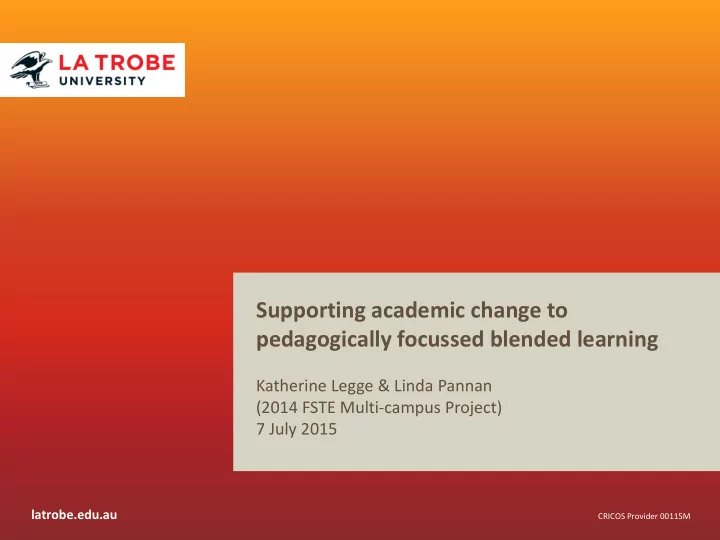

Supporting academic change to pedagogically focussed blended learning Katherine Legge & Linda Pannan (2014 FSTE Multi-campus Project) 7 July 2015 latrobe.edu.au CRICOS Provider 00115M
̶ ̶ ̶ Context Institutional change focused on achieving the most efficient and effective means for course and subject delivery to an anticipated large and diverse student population. Multi-campus delivery re-consider the traditional delivery mode and making use of the rapid growth in educational technologies to support asynchronous learning activities and multi-campus delivery Blended Learning “the lack of consensus on a definition of blended learning and the techno- centric nature of many existing definitions contributes to the unrealised pedagogical potential of blended learning” (Torrisi-Steele, 2011) La Trobe University 2
Blended Learning Effective blended delivery is no different to effective traditional delivery in the requirement that students engage and are comfortable and confident in the way the learning has been structured in the subject. With any delivery mechanism, the student’s learning is paramount and the critical difference lies in the role played by the teacher in the learning process. Our Model To support the academic through this reconceptualization and guide their design and development of effective student-centred blended learning formats. La Trobe University 3
Blended Learning design model Objective To move an academic cohort to an efficient and effective blended learning model in which students take more active control of their learning; formative assessment has an enhanced role in encouraging engagement and performance; and increased active interaction occurs between peers, and between students and their academic teacher at a higher cognitive level. La Trobe University 4
A blended learning cycle Active learning mode transition (f2f online) Active f2f interactive Online learning Learning Active learning mode transition (online f2f) La Trobe University 5
The three components of Blended Learning occurs online and out of class, guided by directions found in the o AOL subject’s online presence completed individually or collaboratively with peers or in an o online/f2f team f2f involves at least 1 hour of scholarly interaction of students with o academic/s and other students in person in the same location follows each online component o students engage in a learning activity to help their successful o progression into the next learning mode There are 2 learning mode transitions, from online-to-f2f and from o f2f-to-online. La Trobe University 6
End of Subject AOL AOL AOL AOL Start learning Active learning mode transition (f2f online) f2f Active Online interactive Learning learning Active learning mode transition (online f2f) Repeated blended learning cycles form a spiral as the subject and learning progress La Trobe University 7
What the students do (each week) La Trobe University 8
What the students do (each week) in PHY1PA 2. Peer-peer collaborative learning • Team Task • Continue Mastering Physics ‘ End of Chapter problems’ 3. Debrief & extension • Submit team solution, & Learning so far is exercised & questions built on in class Q&A/responsive class (1hr) Short Quiz submit releases • Review- respond to team transition (Team) task solution issues & Active learning questions mode • Extension – complex transition applications 1. Preparatory work (~2hr) (online f2f) f2f Active • Guided use of interactive Online Transition: Introduce resources to develop learning Learning resources and & key initial concepts Active learning starting issues for next Student writes notes & mode topic complete ~ 5 Mastering transition Physics ‘tutorials’ (f2f online) 4. Laboratory class (2hr)/ open • workshop Begin End-of-chapter problems Guided • Complete related practical activity • Complete End-of-chapter To next blended problems learning cycle • Begin next topic From previous blended learning La Trobe University 9 cycle
Reference Torrisi-Steele, Geraldine (2011). This Thing Called Blended Learning — A Definition and Planning Approach. In Krause, K., Buckridge, M., Grimmer, C. and Purbrick-Illek, S. (Eds.) Research and Development in Higher Education: Reshaping Higher Education, 34 (pp. 360 – 371). Gold Coast, Australia, 4 – 7 July 2011.
Recommend
More recommend